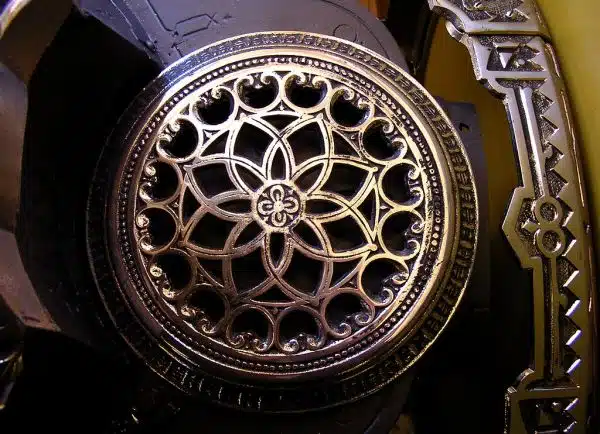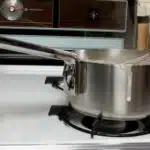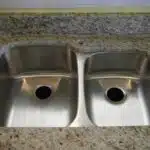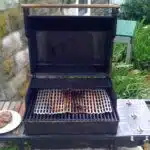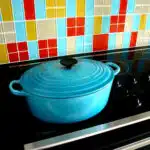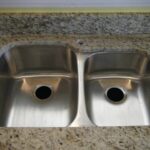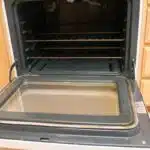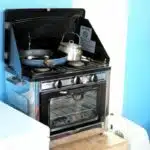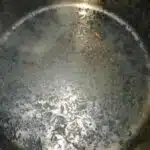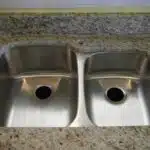The kitchen is often referred to as the heart of the home, and for good reason. It’s where we prepare and share meals with loved ones, entertain guests, and spend countless hours cooking up a storm. However, this also means that our stovetops get a lot of use, leading to buildup on stove grates that can be difficult to clean.
Cleaning stove grates may seem like a daunting task, but with the right tools and techniques, it can be done quickly and efficiently. In this article, I will share my tips and tricks for cleaning stove grates so that you can keep your kitchen looking its best and ensure that your meals are cooked on a clean surface. Whether you’re dealing with grease buildup or stuck-on food particles, these methods will help you tackle even the toughest stains. So let’s get started!
Assessing The Condition Of Your Stove Grates
Maintaining your stove grates is essential to ensure that they last for a long time. Before starting the cleaning process, you need to assess their condition carefully. Look for any visible signs of wear and tear, such as cracks or chips in the metal. If you notice any defects, it’s best to replace them as soon as possible.
Rust prevention is another crucial aspect of maintaining your stove grates. They are prone to rusting due to constant exposure to heat and moisture, which can cause pitting and discoloration. Examine your grates for any rust spots or signs of corrosion. If you find some, use a rust remover solution to eliminate them before proceeding with cleaning.
Regular maintenance is key when it comes to keeping your stove grates in good condition. By taking the time to assess their state and preventing rust buildup, you can extend their lifespan significantly. In the next section, we’ll discuss gathering your cleaning supplies, so you’re ready to tackle even the most stubborn stains on your stove grates.
Gathering Your Cleaning Supplies
To effectively clean stove grates, it is important to gather all the necessary cleaning supplies beforehand. Organizing supplies can help streamline the cleaning process and make it less daunting. Here are three essential items that you will need:
Dish soap: A mild dish soap is an effective cleaning agent that can help remove grease, grime, and food residue from stove grates.
Scrub brush: A stiff-bristled scrub brush can be used to scrub away any stubborn stains or debris that may be stuck on the grates.
Trash bag: A trash bag can be used to dispose of any loose debris or food particles that may have accumulated on the stove grates.
Effective cleaning methods involve using these supplies in a systematic manner to ensure thorough cleaning of the stove grates. Once you have gathered your supplies, start by removing any loose debris or food particles from the grates before applying any cleaning solution. This will prevent further buildup and make it easier for you to scrub away any tough stains or residue.
With these items at hand, organizing your supplies before starting the cleaning process will make it much easier for you to achieve a sparkling clean stove grate without much hassle. Remember, prevention is key when it comes to maintaining a clean kitchen, so always try to clean up spills and messes as soon as possible before they become too difficult to remove.
Removing Loose Debris
Vacuuming is an effective way to remove loose debris from stove grates; brushing with a stiff brush can help reach into small spaces, and scrubbing with a scouring pad can help remove stubborn dirt. Wiping with a damp sponge or towel can help rinse away grime, while scraping with a putty knife or razor blade can help remove tough residue. Soaking in hot water, boiling, using baking soda, vinegar, dish soap, baking powder, or steel wool may also be necessary to properly clean stove grates.
Vacuuming
Have you ever found yourself struggling to remove loose debris from your stove grates? Fear not, as there is a simple solution that will make this task a breeze! Using a vacuum cleaner can be an effective way of removing debris and dirt from your stove grates. Not only does this method save time and effort, but it also ensures that all the grime and dirt are removed thoroughly.
One of the benefits of vacuuming stove grates is that it eliminates the need for scrubbing or using harsh chemicals. Instead, simply attach the crevice tool to your vacuum cleaner and use it to suction all the loose debris from the grate’s surface. Vacuuming prevents scratches on the grates’ surfaces and makes them look brand new without much hassle. Moreover, by using a vacuum cleaner instead of scrubbing with brushes, you prevent damage to the enamel coating on your stove grates.
To get optimal results when vacuuming your stove grates, ensure that your vacuum cleaner has enough suction power. Additionally, ensure that you clean out any loose debris in your crevice tool regularly to avoid clogging. Vacuuming should be done at least once every week or more frequently if necessary depending on how often you use your stove. By following these steps, you will have well-maintained stove grates that sparkle with minimal effort.
In conclusion, using a vacuum cleaner is an excellent way of removing loose debris from stove grates effectively. Not only does this method save time and effort but it also maximizes results while minimizing damage to the enamel coating on your grill top’s surface. Incorporate regular vacuuming into your cleaning routine today for sparkling clean stovetop grates!
Brushing
When it comes to cleaning stove grates, there are various methods you can use to remove loose debris. One of these methods is brushing. Using different brushes for your stove grates can be an effective way of removing dirt and debris that vacuuming may not get rid of. However, it’s important to note that using the wrong type of brush or too much force when scrubbing can damage your stove grates’ enamel coating.
To ensure that you get the best results when brushing your stove grates, here are some tips for effective brushing. Firstly, choose a brush with bristles that are tough enough to remove dirt but soft enough not to scratch the surface of your grate. Secondly, avoid using metal brushes that could scratch or damage the enamel coating on your stove grates. Lastly, use gentle strokes when brushing and avoid applying too much pressure.
Regularly incorporating brushing into your cleaning routine will help maintain clean and shiny stove grates. By following these tips for effective brushing, you can ensure that all loose debris is removed without causing any damage to your grill top’s surface. So grab a brush and start scrubbing away for cleaner and more hygienic cooking surfaces!
Soaking Your Grates
Soaking grates is the most effective way to remove stubborn grease and grime. It softens the dirt and makes it easier to clean, saving you time and effort. Before soaking your grates, make sure to scrub off as much debris as possible with a brush or sponge. This will help to loosen any dirt that has accumulated on the surface of the grate.
To soak your stove grates, fill a large container with hot water and add dish soap or another cleaning solution. Place the grates in the solution and let them soak for several hours or overnight. The longer you soak them, the easier they will be to clean. After soaking, rinse the grates thoroughly with hot water and dry them with a towel.
There are alternative soaking solutions for stove grates that you can try if you don’t have dish soap or prefer a different method. For example, you can use baking soda and vinegar to create a natural cleaning solution that will break down dirt and grease without harsh chemicals. Simply mix equal parts baking soda and vinegar in a bowl until it forms a paste, then spread it over the surface of your grates. Let it sit for several hours before rinsing off with hot water.
Transition: Now that you’ve soaked your stove grates, it’s time to move on to scrubbing them with baking soda and vinegar for an even deeper clean.
Scrubbing With Baking Soda And Vinegar
After soaking your stove grates in hot water, it’s time to remove the buildup of grease and grime. For those who prefer a natural alternative to vinegar, lemon juice can be used instead. The acidic properties in lemon juice are effective in breaking down stubborn stains and leaving your grates looking clean and shiny.
To clean your stove grates with lemon juice, simply mix two cups of water with one cup of lemon juice in a spray bottle. Spray the solution over your grates and let it sit for 10-15 minutes to break down the grease. Afterward, use a steel wool pad to scrub away any remaining residue. Rinse thoroughly with water and dry with a cloth.
If you find that baking soda isn’t strong enough to tackle the tough stains on your stove grates, try using steel wool instead. Steel wool is an abrasive material that can effectively remove even the most stubborn stains without scratching or damaging the surface of your grates. Simply wet the steel wool pad and scrub in circular motions until all traces of grease are removed. Rinse thoroughly with water before drying.
Next up: for those stubborn stains that just won’t budge, consider using ammonia as an alternative cleaning method. This powerful cleaning agent is highly effective at breaking down tough stains and restoring your stove grates to their original shine. However, it’s important to use caution when working with ammonia as it can be harmful if not used properly.
Using Ammonia For Tough Stains
Like a stubborn storm cloud that refuses to dissipate, tough stains on stove grates can be a challenging issue for many homeowners. However, with the right knowledge and tools at your disposal, you can quickly tackle these stubborn stains and restore your stove grates to their former glory. One effective method of removing tough stains is by using ammonia.
When dealing with tough stains on stove grates, it’s essential to take adequate safety precautions. Always wear gloves when handling ammonia as it can cause skin irritation or burns. Additionally, ensure that your workspace is properly ventilated to prevent inhaling harmful fumes.
To use ammonia for cleaning stove grates, mix equal parts of ammonia and water in a large plastic bag. Place the grates inside the bag and seal it tightly before leaving it overnight to soak. The next day, remove the grates from the bag and rinse them thoroughly with water before drying them off.
If you prefer not to use ammonia or are looking for alternatives, there are other solutions available that can be just as effective. Baking soda mixed with water or vinegar can work wonders on tough stains without any harsh chemicals. For particularly stubborn stains, salt mixed with baking soda and water can also do the trick.
With these tips at your disposal, you’ll never have to worry about tough stains on your stove grates again. In the next section, we’ll explore how applying a degreaser can help keep your stove grates looking clean and shiny.
Applying A Degreaser
- Before applying a degreaser, it is important to ensure that the stove grates are cooled off entirely and that all food and debris are removed.
- The degreaser should be applied in a thin and even layer, allowing the chemical to penetrate the grease and grime.
- For best results, the degreaser should be left to sit for a few minutes, allowing it to thoroughly break down the grease and residue.
- Afterwards, the grates should be washed with warm, soapy water and rinsed clean.
Preparing Degreaser
Before applying any degreaser to your stove grates, it is important to prepare the cleaner properly. There are two types of degreasers: homemade and store bought. Homemade degreasers can be made from natural ingredients such as vinegar and baking soda, while store bought degreasers come in spray bottles and contain chemicals that are specifically formulated to remove grease.
To make a homemade degreaser, mix equal parts vinegar and water in a spray bottle. If you prefer a thicker consistency, add baking soda until it forms a paste-like texture. Store bought degreasers can be purchased at any home improvement store or supermarket. Be sure to read the label carefully before purchasing to ensure that it is safe for use on stove grates.
Once you have chosen your preferred type of degreaser, apply it generously to the stove grates. Allow it to sit for several minutes so that the cleaner has time to break down the grease build-up. After the allotted time, use a scrub brush or sponge to remove any remaining residue. Rinse thoroughly with warm water and dry with a clean towel. By following these steps, your stove grates will be free of grease and looking brand new in no time!
Applying Degreaser
When it comes to cleaning your stove grates, using a degreaser is an effective way to remove stubborn grease build-up. However, it’s important to choose the right type of degreaser for the job. For those who prefer eco-friendly options, homemade degreasers made from natural ingredients like vinegar and baking soda are a great choice. On the other hand, store-bought degreasers that contain chemicals can also be effective as long as they are safe for use on stove grates.
Once you have chosen your preferred type of degreaser, applying it properly is key to achieving optimal results. To start, make sure that your stove grates are cool before applying any cleaner to avoid burns or damage to the surface. Next, apply the degreaser generously and allow it to sit for several minutes so that it has time to break down the grease. For even better results, cover the grates with plastic wrap or a plastic bag during this time so that the cleaner doesn’t dry out too quickly.
When it comes time to scrub away any remaining residue, using a scrub brush or sponge is recommended over steel wool pads which can scratch or damage the surface of your stove grates. Be sure to rinse thoroughly with warm water afterwards and dry with a clean towel. By following these tips for applying degreaser more effectively, your stove grates will be looking clean and shiny in no time!
Using A Pressure Washer
Pressure washing is an effective way to clean stove grates. However, it is important to note that pressure washers can be dangerous and should only be used by those who are knowledgeable in their operation. An alternative to using a pressure washer would be to soak the grates overnight in hot, soapy water and scrub them with a wire brush the next day.
One of the pros of using a pressure washer is that it can quickly remove tough stains and grease buildup on stove grates. It is also an efficient way to clean large surfaces without having to do much manual labor. However, there are cons to using a pressure washer as well. For example, if not used properly, it can damage the grates or even cause injury. Additionally, some pressure washers require gas or electricity which can add to the overall cost.
Before deciding whether or not to use a pressure washer on your stove grates, consider the pros and cons listed above. If you have experience with operating one safely and efficiently, then it may be worth giving it a try. Otherwise, there are alternative methods such as soaking and scrubbing that may work just as well for you.
Transition: Now that we have discussed the pros and cons of using a pressure washer on stove grates, let’s explore another cleaning method – using a steam cleaner.
Using A Steam Cleaner
After using a pressure washer to clean your stove grates, you may want to consider using a steam cleaner as an alternative method. Using steam cleaners for cleaning stovetop grates has become increasingly popular in recent years due to its numerous benefits.
Benefits of using steam cleaners include their ability to remove tough stains and grease without the use of chemicals. Steam cleaners are also effective at killing bacteria and germs, making them a hygienic option. Another advantage is that they can be used on various surfaces such as stainless steel, ceramic, and glass cooktops.
However, there are also some drawbacks to using steam cleaners. One issue is that it can take longer than other cleaning methods since the steam needs time to penetrate and break down the grime. Additionally, some models may not have enough power to remove really tough stains or burnt-on food residue.
When comparing steam cleaning with other methods such as scrubbing with soap and water or using chemical-based cleaners, it’s important to consider your personal preferences and needs. While steam cleaning may take longer, it does offer a more environmentally-friendly option that doesn’t involve harsh chemicals.
Next up: Cleaning Cast Iron Grates – Here’s what you need to know!
Cleaning Cast Iron Grates
Cast iron grates are a popular choice for many home cooks due to their durability and ability to retain heat. However, they require special care when it comes to cleaning and maintenance. To keep your cast iron grates in good condition, it is essential to season them properly before use. This process involves coating the grates with oil and heating them in the oven, which creates a non-stick surface that prevents food from sticking.
To prevent rust from forming on your cast iron grates, it is important to keep them dry and well-seasoned. After each use, wipe the grates down with a clean towel or paper towel to remove any moisture or food debris. Then, apply a thin layer of vegetable oil or another high-heat cooking oil to the grates and heat them over low heat for 10-15 minutes. This will help to maintain the seasoning and prevent rust from forming.
Regular maintenance of your cast iron grates will extend their lifespan and ensure optimal performance. By following these simple steps for seasoning and preventing rust, you can enjoy using your cast iron grates for years to come.
As important as it is to maintain your cast iron grates, cleaning them can be a daunting task. In the next section, we will discuss how to clean porcelain grates effectively without damaging them.
Cleaning Porcelain Grates
After learning how to clean cast iron grates, let’s move on to porcelain grates maintenance tips and tricks. Porcelain grates are the most delicate type of stove grates, as they can easily chip or break if not handled properly. It’s essential to clean them regularly and gently to extend their lifespan.
To begin cleaning porcelain grates, remove them from the stove and place them in a sink filled with hot soapy water. Let them soak for at least 30 minutes before scrubbing away any residue using a soft-bristled brush or sponge. Avoid using abrasive cleaners, steel wool pads or harsh chemicals that can damage the porcelain finish.
When it comes to choosing the best cleaning products for porcelain stove grates, here are three options worth considering:
Baking Soda: Mix baking soda with warm water until you have a paste-like consistency. Apply the mixture onto the grate surface and let it sit for 10-15 minutes before rinsing with water.
Vinegar: Spray undiluted white vinegar onto the grate surface and let it sit for 5-10 minutes before scrubbing away any debris using a soft brush or sponge.
Dish Soap: Add a few drops of dish soap onto a sponge or soft-bristled brush and scrub away any food residue. Rinse thoroughly with water after cleaning.
These three cleaning products are affordable, eco-friendly and readily available in most households. Now that we’ve covered porcelain grate maintenance tips and tricks let’s move on to the next section about cleaning stainless steel grates without damaging their surface shine.
Cleaning Stainless Steel Grates
Cleaning stainless steel grates can be a daunting task, but it is essential to maintain their longevity and aesthetic appeal. After you have removed the grates from your stove, it’s time to get started with cleaning them. Start by using a mild soap solution and a soft-bristled brush to scrub away any grease or food residue that may have accumulated on the surface of the grates.
Once you have scrubbed away all visible stains, it’s time to move on to polishing techniques that will help restore the shine of your stainless steel grates. You can either use a commercial stainless steel cleaner or make your own by mixing baking soda and water in equal proportions. Apply the solution onto the surface of the grates and rub gently with a microfiber cloth until you see a noticeable improvement in their appearance.
Lastly, preventing future stains is crucial in ensuring that your stainless steel grates remain clean and shiny for longer periods. One way to do this is by wiping down your grates after every use with a damp cloth or paper towel. This helps eliminate any grease or food residue before they have time to dry out and become stubborn stains. Additionally, avoid using harsh chemicals or abrasive cleaners as they can cause damage and discoloration to your stainless steel grates over time.
Moving on to drying your grates, ensure that they are completely dry before reattaching them back onto your stove. Moisture left behind can cause rusting, which will ultimately reduce their lifespan. Therefore, take time to wipe down each grate thoroughly with a dry towel or allow them air dry naturally before putting them back into place.
Drying Your Grates
In cleaning stainless steel grates, it is essential to ensure that they are properly dried after washing. The importance of air drying cannot be overstated as it helps to prevent any water droplets from remaining on the grates, which could lead to rust formation. This is especially important for your stove grates, as they are constantly exposed to heat and moisture.
To dry your grates effectively, you can use a clean towel or paper towel to wipe them down and remove any excess water. However, this method may not always be sufficient, especially if you have large or heavy grates. In such cases, leaving the grates out in the open air for a few hours can help to ensure that they are completely dry before being returned to the stove.
Preventing rust formation is crucial in maintaining your stove grates’ longevity and overall appearance. By taking care of your stove grates and ensuring that they are properly cleaned and dried after every use, you can prevent rust from forming on the surface. This will not only help your stove look better but also prevent any potential health hazards from rust particles getting into your food during cooking.
Moving forward, maintaining your clean stove grates is just as important as cleaning them. In the next section, we will explore some simple tips for keeping your stove grates looking their best over time.
Maintaining Your Clean Stove Grates
Once you’ve successfully cleaned your stove grates, it’s essential to maintain them properly. Regular maintenance will prevent the buildup of grease and grime, ensuring that they remain in good condition for longer. Here are some tips for maintaining your clean stove grates:
Wipe down your stove grates after each use: Use a damp cloth or sponge to remove any spills or splatters as soon as possible. This will prevent them from hardening and becoming difficult to remove later.
Use a degreaser: Once a week, use a degreaser specifically designed for stovetops to dissolve any stubborn grease buildup.
Store your stove grates correctly: When not in use, store your stove grates in a dry place away from moisture and humidity that can cause rusting.
By following these best practices for maintaining your clean stove grates, you can ensure that they remain functional and hygienic for years to come. In addition to regular cleaning and maintenance, there are also several things you can do to prevent grime buildup on your stove grates.
For instance, placing a layer of aluminum foil over the burners will catch any spills or splatters before they have the chance to stick to the grate. You can also consider investing in non-stick cookware, which will reduce the amount of grease and food residue left behind on your stovetop.
In the next section, we’ll discuss some common issues that you may encounter when cleaning and maintaining your stove grates – and how to troubleshoot them effectively.
Troubleshooting Common Issues
When it comes to cleaning stove grates, there are a few common issues that can arise. One of the most frequent issues is the buildup of grease and grime on the grates, which can be difficult to remove if left unattended for too long. Another issue is rusting, which can occur if the grates are not properly cared for or stored in a humid environment. Lastly, some grates may become discolored over time due to exposure to heat and cooking oils.
Fortunately, there are several common solutions to these problems. For grease buildup, using a degreaser specifically designed for stovetops can be effective in breaking down the stubborn stains. For rusted grates, using a wire brush to scrape off the rust and then applying a layer of oil can help prevent future rusting. Discoloration can often be remedied by soaking the grates in hot water mixed with baking soda and vinegar overnight.
Preventative measures are also key in maintaining clean stove grates. Always wipe down your stovetop after each use and avoid leaving food spills or grease splatters for too long. Additionally, try to store your grates in a dry place when not in use and avoid exposing them to moisture or humidity.
By following these tips and regularly cleaning your stove grates, you can ensure they remain in good condition for years to come. Remember that prevention is key when it comes to maintaining cleanliness and avoiding common issues that can arise with stove grates.
Conclusion
In conclusion, cleaning stove grates can be a daunting task, but with the right approach and supplies, it can be done efficiently. Assessing the condition of your stove grates is crucial as it determines the level of cleaning needed. Gathering your cleaning supplies beforehand saves time and ensures that you have everything you need to get started.
Removing loose debris, soaking your grates in baking soda and vinegar solution, scrubbing stainless steel grates with a soft-bristled brush, drying your grates thoroughly and maintaining them appropriately are some of the tips highlighted in this article. Troubleshooting common issues such as rust stains or burnt-on food bits can help restore your stove grates to their sparkling clean state. As the famous saying goes “Cleanliness is next to godliness,” maintaining a clean kitchen space not only promotes hygiene but creates a serene environment for food preparation.
Image Credits
- “stove grate” by Muffet (featured)

